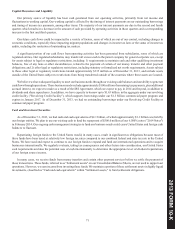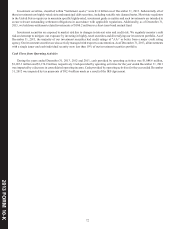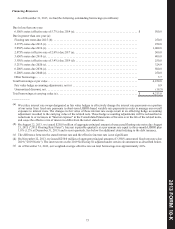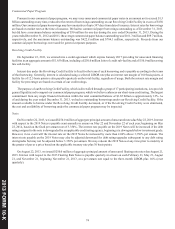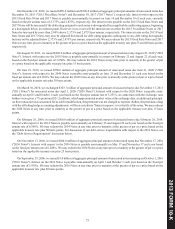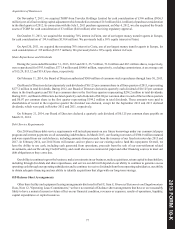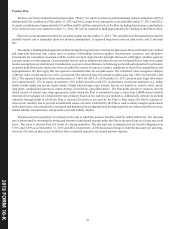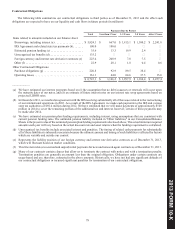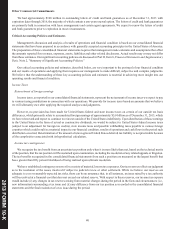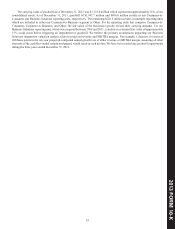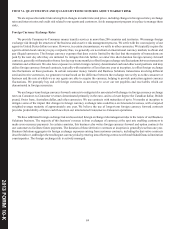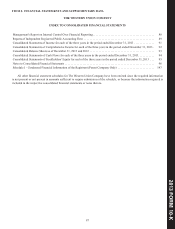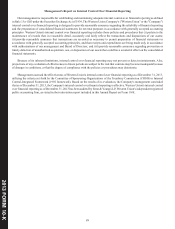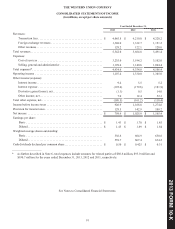Western Union 2013 Annual Report Download - page 191
Download and view the complete annual report
Please find page 191 of the 2013 Western Union annual report below. You can navigate through the pages in the report by either clicking on the pages listed below, or by using the keyword search tool below to find specific information within the annual report.
2013 FORM 10-K
81
We were incorporated in Delaware as a wholly-owned subsidiary of First Data on February 17, 2006. On September 29, 2006,
First Data distributed all of its money transfer and consumer payments businesses and its interest in a Western Union money
transfer agent, as well as its related assets, including real estate, through a tax-free distribution to First Data shareholders (the
"Spin-off"). Pursuant to the tax allocation agreement signed in connection with the Spin-off from First Data, we believe we have
appropriately apportioned the taxes between First Data and us. If we are required to indemnify First Data for taxes incurred as a
result of the Spin-off being taxable to First Data, it likely would have a material adverse effect on our business, financial condition,
results of operations and cash flows.
Our tax contingency reserves for our uncertain tax positions, including those related to the Spin-off, as of December 31, 2013
were $125.5 million, including accrued interest and penalties, net of related items. While we believe that our reserves are adequate
to cover reasonably expected tax risks, in the event that the ultimate resolution of our uncertain tax positions differs from our
estimates, we may be exposed to material increases in income tax expense, which could materially impact our financial condition,
results of operations and cash flows.
Derivative Financial Instruments
We use derivatives to (a) minimize our exposures related to changes in foreign currency exchange rates and interest rates and
(b) facilitate cross-currency Business Solutions payments by writing derivatives to customers. We recognize all derivatives in
"Other assets" and "Other liabilities" in our Consolidated Balance Sheets at their fair value. Certain of our derivative arrangements
are designated as either cash flow hedges or fair value hedges at the time of inception, and others are not designated as accounting
hedges.
• Cash Flow hedges - Cash flow hedges consist of foreign currency hedging of forecasted revenues, as well as hedges of
the forecasted issuance of fixed rate debt. Derivative fair value changes that are captured in accumulated other
comprehensive loss are reclassified to earnings in the same period or periods the hedged item affects earnings, to the
extent the change in the fair value of the instrument is effective in offsetting the change in fair value of the hedged item.
The portions of the change in fair value that are either considered ineffective or are excluded from the measure of
effectiveness are recognized immediately in "Derivative gains/(losses), net."
• Fair Value hedges - Fair value hedges consist of hedges of fixed rate debt, through interest rate swaps. The changes in
fair value of these hedges, along with offsetting changes in fair value of the related debt instrument attributable to changes
in the benchmark interest rate, are recorded in interest expense.
The accounting guidance related to derivative accounting is complex and contains strict documentation requirements. The
details of each designated hedging relationship must be formally documented at the inception of the arrangement, including the
risk management objective, hedging strategy, hedged item, specific risks being hedged, the derivative instrument, how effectiveness
is being assessed and how ineffectiveness, if any, will be measured. The derivative must be highly effective in offsetting the changes
in cash flows or fair value of the hedged item, and effectiveness is evaluated quarterly on a retrospective and prospective basis. If
the hedge is no longer deemed effective, we discontinue applying hedge accounting to that relationship prospectively.
While we expect that our derivative instruments that currently qualify for hedge accounting will continue to meet the conditions
for hedge accounting, if hedges do not qualify for hedge accounting, the changes in the fair value of the derivatives used as hedges
would be reflected in earnings which could have a significant impact on our reported results. As of December 31, 2013, the
cumulative pre-tax unrealized losses classified within accumulated other comprehensive loss from such cash flow hedges that
would be reflected in earnings if our hedges were disqualified from hedge accounting was $43.6 million. As of December 31,
2013, the cumulative debt adjustments from our fair value hedges that would be reflected in earnings if such hedges were disqualified
from hedge accounting was a $0.9 million gain.
Other Intangible Assets
We capitalize acquired intangible assets as well as certain initial payments for new and renewed agent contracts and software.
We evaluate such intangible assets for impairment on an annual basis or whenever events or changes in circumstances indicate
the carrying amount of such assets may not be recoverable. In such reviews, estimated undiscounted cash flows associated with
these assets or operations are compared with their carrying amounts to determine if a write-down to fair value (normally measured
by the present value technique) is required.


